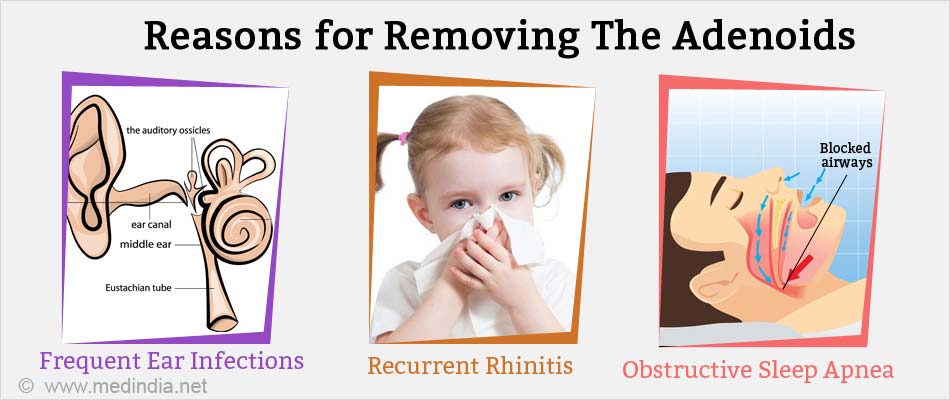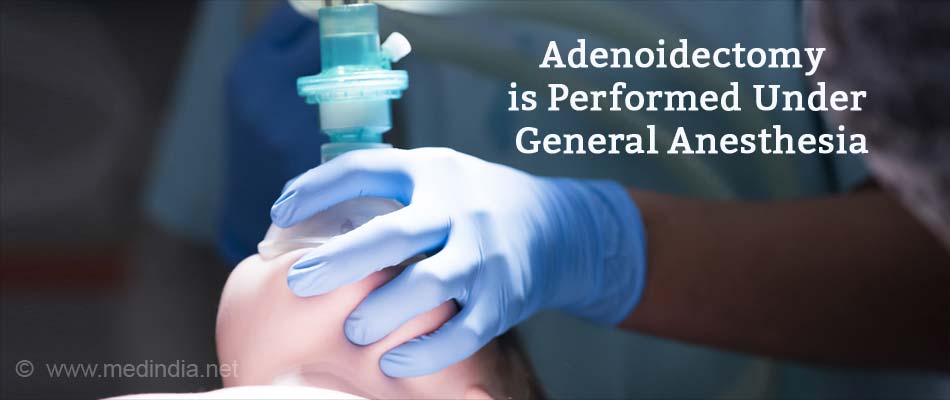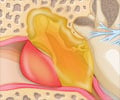What are Adenoids?
The adenoids are a lymphatic mass of tissue located behind the nose where the nose meets the throat. The air we breathe passes over the adenoids. Although the adenoids provide immunity against pathogens, the immunity of a child is not affected when they are removed. Adenoids start shrinking in size at around 6 years of age and they are not visible in adults. It is also known as pharyngeal tonsil.
Adenoidectomy is a surgery which involves removal of the adenoid gland.
Adenotonsillectomy is a procedure where both the tonsils and the adenoids are removed at the same time.
What are the Indications for Adenoidectomy?
When the adenoids get inflamed (adenoiditis) and swollen, it results in sore throat, fever, mouth breathing, snoring, disturbed sleep and nasal voice. These symptoms most commonly occur in children but may be encountered in adults occasionally. Initially symptoms of adenoiditis are treated with antibiotics.
When the infection or inflammation does not respond to antibiotics or there is frequent recurrence of infection affecting the quality of life of the patient, surgical intervention may be necessary. The following are a few reasons to remove the adenoids.
- To clear the airway: The adenoids get enlarged in some children due to different causes. Depending on the enlargement it can block the air flow especially during sleep; this results in snoring or sometimes apnea due to obstruction and is known as obstructive sleep apnea. It can also result in daytime breathing problems, poor concentration, behavioral changes and learning disabilities in the child. Removing the adenoids along with tonsils will solve the obstructive problem. Adenoidectomy and tonsillectomy are usually done together.
- To treat frequent ear infections: Impaired function of the Eustachian tube is seen in children with frequent adenoid infection and enlargement because its opening is situated close to the adenoids. Impaired function of the Eustachian tube can lead to recurrent middle ear inflammation and otitis media. So in patients with recurrent middle ear infection due to adenoids, adenoidectomy is preferred.
- Recurrent sinusitis: Recurrent nasal infections which subside on antibiotics and recur on stopping medications, if not treated appropriately can lead to chronic sinusitis. Adenoidectomy has shown an improvement in such patients.

How do you Prepare for Adenoidectomy?
You will consult an ear nose throat (ENT) specialist for undergoing adenoidectomy procedure. First a thorough patient history profile and physical examination that includes the examination of the adenoids using a special instrument equipped with a mirror and light are done. If the doctor feels surgery is necessary, you can choose a date of your convenience and you will be given certain instructions to follow:
- Avoid blood thinners like aspirin for one week before the surgery.
- Avoid medications for pain and fever except for paracetamol for 3 days before surgery.
- Avoid consuming food and drinks before the surgery for at least 8 hours.
- If your child has to take any medication before surgery, he/she can take them with a sip of water.
- Prepare your child for the surgery by explaining the procedure and answering his questions.
- You will have to undergo some routine blood tests and urine tests advised by the doctor, and chest x-ray. An electrocardiogram (ECG) will be requested in adult patients to check the heart condition.
- You will be asked to consult the anesthetist who will assess you and state that you are fit to undergo the procedure.
- You will be asked to get admitted to the hospital on the evening/night before surgery to ensure all instructions are followed before surgery.
What is Adenoidectomy Procedure?
- Adenoidectomy is done under general anesthesia by the ENT surgeon.

- On the morning of the surgery, you will be given a surgical gown to wear after your bath and transferred to the operation theater.
- Inside the theater, you will be lifted and laid on the operating table before the start of the operation.
- The anesthetist will give some intravenous drugs to sedate the patient.
- A tube will be placed in the airway to deliver oxygen to the lungs. The child will sleep and will not experience the pain during the procedure.
- The child’s vital signs such as pulse and blood pressure are monitored constantly throughout the procedure.
- A small tool is used to keep the mouth open during the procedure. The surgery takes place through the mouth. No skin incisions are required for adenoidectomy.
- Various techniques are used to remove the adenoid tissue.
- Curette: It is a spoon-shaped tool which can be used to remove the adenoids

- Electrocautery: Heat (diathermy) is used to remove the adenoids and arrest the bleeding in this technique.
- Radiofrequency ablation: Radiofrequency is used to remove the adenoids.
- After removing the adenoids, packing material is placed to manage the bleeding.
What Happens after the Adenoidectomy?
Recovery room:
- The procedure takes around 30 minutes. The child will be shifted to the recovery room after the procedure where the child will stay for an hour under the supervision of nurses.
Post-operative recovery:
- The child may then be shifted to the post-operative stay area for complete recovery. The child can eat and drink a few hours after the surgery in spite of a little throat pain.
- The child will be discharged on the day of the surgery or on the next day.
- Adequate hydration is necessary after the surgery. Encourage your child to drink liquids.

- He or she will be able to drink liquids a few hours after surgery followed by soft soups and soft solids in a day or two.
- If the child complains of throat or neck pain, you may give Paracetamol or Ibuprofen.
- The child may have vomiting tendencies for 1-2 days after the procedure.
- Fever after the surgery is common, which may take around 3 days to subside.
- Neck pain, bad breath and snoring after the surgery can be expected which may subside in 2-3 weeks after surgery.
- Please allow one to two weeks for total recovery.
- Pain killers and antibiotics will be given to make recovery smooth
- The child can resume normal activities after 2 days. However, avoid vigorous exercise for a week.
- Your child will need at least a week’s rest and recovery returning to school.
- Avoid contact with people who have colds or other infections to avoid contracting an infection.
- After the procedure there will be a decrease in the frequency of ear infections and the child can breathe better.
What are the Risks & Complications of Adenoidectomy?
The complications of the surgery are:
- Bleeding
- Infection
- No improvement in the breathing, nasal drainage or ear infections
- Risk due to anesthesia
- Adenoids rarely grow after the removal









